ASUS Launches ROG Zephyrus M (GM501): A More Traditional Flagship Gaming Notebook
by Anton Shilov on April 3, 2018 2:30 PM EST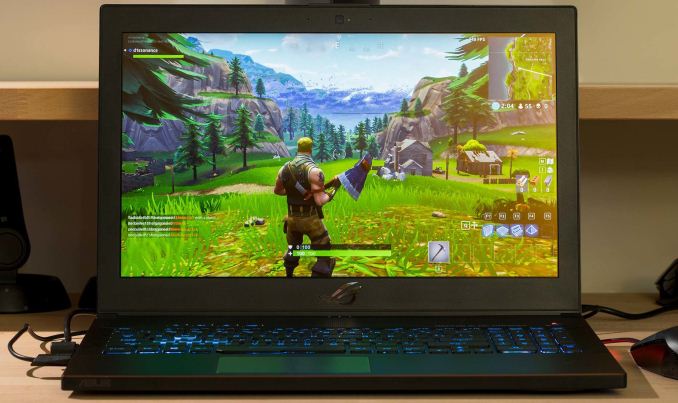
ASUS this week introduced its a second laptop under its flagship ROG Zephyrus gaming notebook brand. Dubbed the Zephyrus M (GM501) the new laptop is a slightly more straight-laced counterpart to the original Zephyrus, eschewing the latter's gaming-optimized keyboard and trackpad layout in favor of a traditional keyboard-over-trackpad design. Otherwise the new notebook is very similar to the original in most respects, aiming for the high-performance market by packing in Intel’s newly announced six-core Core i7-8750H along with NVIDIA’s GeForce GTX 1070 graphics chip into a 0.78-inch (19.9 mm) thick chassis. The new notebook is only slightly thicker than the original ROG Zephyrus, but unlike its predecessor, it has a GPU that runs at its original frequency and claims to deliver performance similar to its desktop counterparts.
The ASUS ROG Zephyrus M GM501 is based on Intel’s six-core Core i7-8750H CPU (2.2 GHz base, up to 4.2 GHz turbo) and is accompanied by 16 GB of DDR4-2666 RAM (upgradeable to 32 GB). Meanwhile along with the keyboard change, the other big difference between the two Zephyrus laptops is on the dGPU front: the Zephyrus M starts with an NVIDIA GeForce GTX 1060 and a fittingly lower base price, whereas the original Zephyrus only ships in a flagship GTX 1080 configuration. Or for a more powerful graphics system the GTX 1070 is offered as an upgrade option. And unlike the original laptop, which took some liberties with GPU clockspeeds to keep the powerful GTX 1080 Max-Q in check (e.g. tuning that involves frequency drops and some other ways to trim TDP), the Zephyrus M runs its dGPU at NVIDIA"s standard clockspeeds.
In order to integrate full-fat GPUs, ASUS had to use a new chassis that is a couple of millimeters thicker when compared to the original ROG Zephyrus — the new laptop is 19.9 mm thick, which is still thinner than the vast majority of gaming notebooks. Besides getting slightly thicker, the system is also 250 grams heavier and now weighs 2.45 kilograms (5.5 lbs).
To ensure sufficient cooling of rather hot components (the aggregated TDP of the CPU and the GPU is rated at 160 W) and maintain consistent performance under high loads, the new ROG Zephyrus M uses a cooling system that resembles that of the original ROG Zephyrus: it has two blowers and five thick heat pipes. When the laptop is opened, additional venting opens up to improve air flow.
The thicker and heavier enclosure enabled the manufacturer to equip its ROG Zephyrus M with a rather sophisticated storage sub-system: the new GM501 comes with a 256 GB PCIe 3.0 x4 SSD as well as Seagate’s 1 TB FireCuda SSHD. Another important improvement of the ROG Zephyrus M compared to the original one is its display panel with a 144 Hz refresh rate and a 3 ms response time. The display supports NVIDIA’s G-Sync dynamic refresh rate technology.
Meanwhile, as previously mentioned, the new model incorporates a more traditional keyboard setup. This means forgoing the original model's gaming optimized trackpad-next-to-keyboard setup in favor of the more traditional keyboard-over-trackpad setup. While Asus continues to offer the less traditional layout on the standard Zephyrus, the Zephyrus M is meant to be a bit more approachable and a bit more versitile for tasks that aren't gaming. As a result, the Zephyrus M gets a proper physical number pad in place of where the original put its trackpad. Plus the slightly larger chassis has allowed Asus to extend the key travel distance of the keyboard by a bit, again to be a little more traditional, bringing the travel distance up from 1.4mm to 1.7mm.
Furthermore, the Zephyrus M comes with Intel’s latest Wireless-AC 9560 CRF that uses the onboard chipset Wi-Fi, supporting 802.11ac Wave 2 at up to 1.73 Gbps throughput. Bluetooth also included. As for physical connectivity, the new Zephyrus M resembles its ancestor: it has one Thunderbolt 3 port, four USB 3.1 Gen 2 connectors, one HDMI 2.0 output, an HD webcam, a microphone array, speakers, and a TRRS mini-jack.
| ASUS ROG Zephyrus M GM501 | |||
| Zephyrus M GM501GS-XS74 | Zephyrus M GM501GM-WS74 | ||
| Display | Diagonal | 15.6" | |
| Resolution | 1920×1080 | ||
| Refresh | 144 Hz, NVIDIA G-Sync | ||
| CPU | Core i7-8750H 6C/12T 2.2 - 4.2 GHz 45 W TDP |
||
| Graphics | NVIDIA GeForce GTX 1070 8 GB | NVIDIA GeForce GTX 1060 6 GB | |
| RAM | 16 GB DDR4-2666 (upgradeable to 32 GB) | ||
| Storage | SSD | 256 GB SSD with PCIe 3.0 x4 interface, up to 3.1 GB/s | |
| HDD | Seagate FireCuda 1 TB SSHD | ||
| Wi-Fi | Intel Wireless-AC 9560 CRF 802.11ac Wi-Fi Wave 2 |
||
| Bluetooth | Bluetooth 4.2 | ||
| Ethernet | 1 GbE controller | ||
| USB | 4 × USB 3.0 Type-A 1 × USB 3.1 Type-C (via TB3 connector) |
||
| Thunderbolt | 1 × USB Type-C Thunderbolt 3 connector | ||
| Display Outputs | 1 × DisplayPort 1.2 (via TB3 port) 1 × HDMI 2.0 |
||
| Keyboard | Chicklet RGB-backlit keyboard | ||
| Other I/O | Microphone, stereo speakers, audio jacks, webcam | ||
| Battery | 50 Wh | ||
| Dimensions | Width | 384 mm | 15.1 inches | |
| Depth | 262 mm | 10.3 inches | ||
| Thickness | 19.9 mm | 0.78 inches | ||
| Weight | 2.45 kilograms | ||
| Price | $2199 | $1899 | |
The ASUS ROG Zephyrus M gaming notebooks will be available from leading retailers in the coming weeks. The model with the GeForce GTX 1060 will be priced at $1,899, whereas the SKU with the GeForce GTX 1070 will cost $2,199.
ROG Zephyrus (GX501GI) Refreshed As Well
Meanwhile not to be left out, the original ROG Zephyrus has also received a minor update to keep it in line with its straight-laced sibling and to incorporate Intel's newest processors. The new ROG Zephyrus (GX501GI) uses Intel's Core i7-8750H – bumping that laptop up from a quad-core to a hex-core – while continuing to pair it with NVIDIA's GeForce GTX 1080 Max-Q on the GPU side of matters. The laptop has also received a minor display upgrade, incorporating the same 144Hz panel as the Zephyrus M and replacing the original 120Hz panel.
Otherwise, the new laptop is a straightforward specificaition bump. Asus has retained the same chassis design and build parameters, including the advanced cooling system and the laptop's unorthodox gaming-focused keyboard. Asus will begin taking pre-orders for it today, with prices starting at $2899.
| ASUS ROG Zephyrus (GX501GI) | |||
| Zephyrus GX501GI (2018) | Zephyrus GX501VI (2017) | ||
| Display | Diagonal | 15.6" | |
| Resolution | 1920×1080 | ||
| Refresh | 144 Hz, NVIDIA G-Sync | 120 Hz, NVIDIA G-Sync | |
| CPU | Core i7-8750H 6C/12T 2.2 - 4.2 GHz 45 W TDP |
Core i7-7700HQ 4C/8T 2.8 - 3.8 GHz 45 W TDP |
|
| Graphics | NVIDIA GeForce GTX 1080 Max-Q 8 GB | ||
| RAM | 16 GB DDR4-2666 (upgradeable to 24 GB) | ||
| Storage | 512 GB SSD, NVMe PCIe x4 | ||
| Wi-Fi | 802.11ac Wi-Fi | ||
| Bluetooth | Bluetooth 4.2 | ||
| Ethernet | 1 GbE controller | ||
| USB | 4 × USB 3.0 Type-A 1 × USB 3.1 Type-C (via TB3 connector) |
||
| Thunderbolt | 1 × USB Type-C Thunderbolt 3 connector | ||
| Display Outputs | 1 × DisplayPort 1.2 (via TB3 port) 1 × HDMI 2.0 |
||
| Keyboard | Chicklet RGB-backlit keyboard | ||
| Other I/O | Microphone, stereo speakers, audio jacks, webcam | ||
| Battery | 50 Wh | ||
| Dimensions | Width | 379 mm | |
| Depth | 262 mm | ||
| Thickness | 16.9-17.9 mm | ||
| Weight | 2.2 kilograms | ||
| Price | $2899 | $2699 | |
Related Reading
- Digital Storm Equinox: 15.6-inch 1080p144 with Core i7 and GTX 1070 Max-Q
- GIGABYTE Updates Aero 15: Six-Cores, GTX 1070, 1080p, 144 Hz, 5mm Bezel, $2300
- ASUS ROG Zephyrus with Core i7-7700HQ and GeForce GTX 1070 Available for $2299
- ASUS Reveals The Ultra-Slim ROG Zephyrus Laptop With GTX 1080 Max-Q
- Acer Announces Predator Triton 700 Gaming Laptop: Core i7, GeForce GTX 10 Series, & 1 TB SSD
Source: ASUS


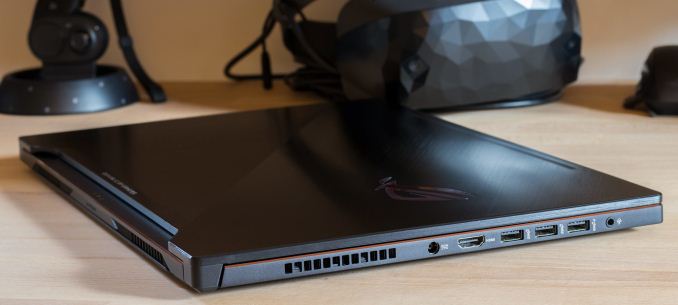
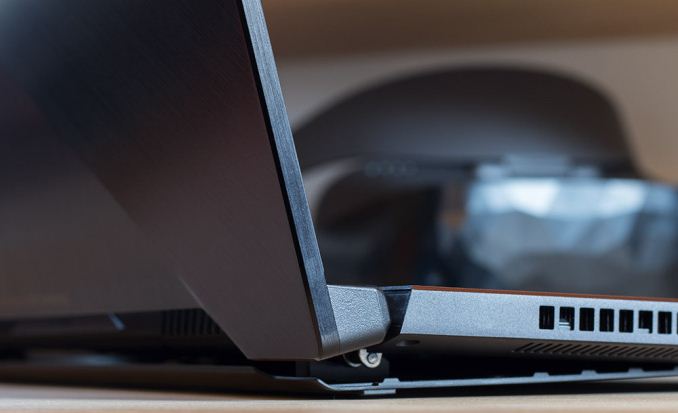
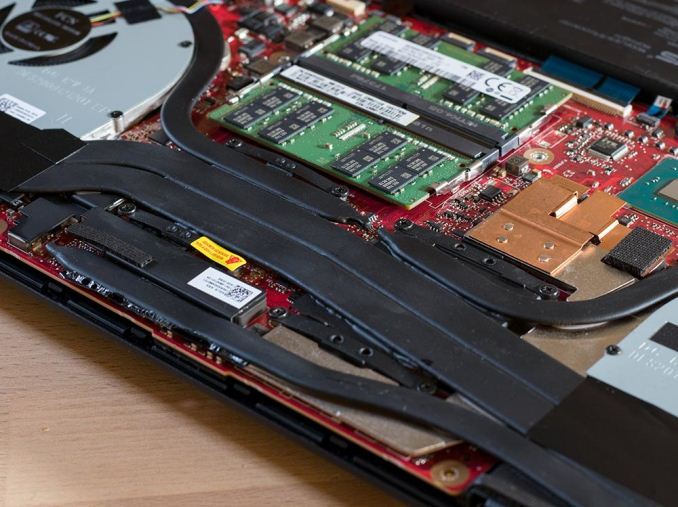


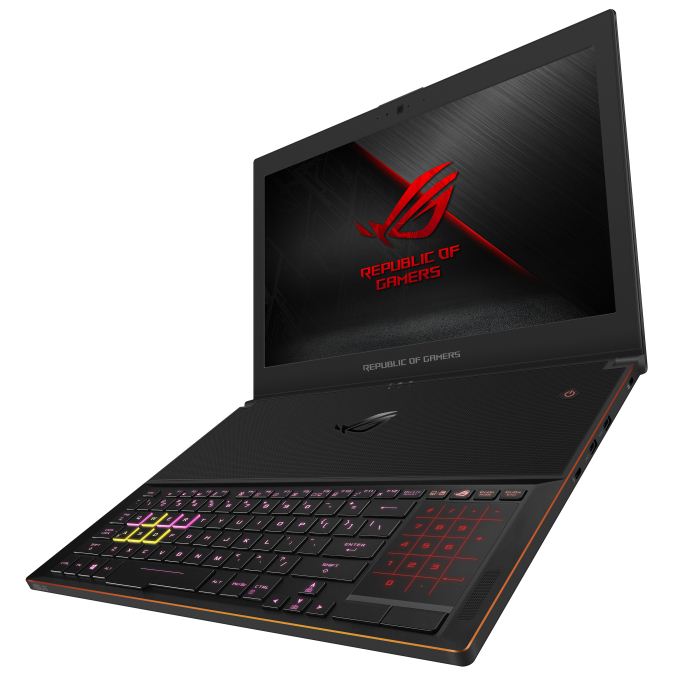









11 Comments
View All Comments
lazarpandar - Tuesday, April 3, 2018 - link
They need to make that screen edge to edgedamianrobertjones - Wednesday, April 4, 2018 - link
...and once it is, with an inflated price, what would you complain about then?Spunjji - Wednesday, April 4, 2018 - link
Yelling at clouds is the next logical step.boeush - Tuesday, April 3, 2018 - link
Maybe it's just me, but that lift-up-the-chassis mechanism when the screen is opened (to provide additional cooling/airflow and hot-surface standoff/isolation regardless of what surface the laptop is on, or how it's being held), strikes me as really neat and clever. Kind of shocking, in retrospect, that nobody had thought of such a thing until now. A mark of legit innovation, I suppose. Kudos to ASUS!Lolimaster - Wednesday, April 4, 2018 - link
Still shitty screens with shitty aspect ratio.OLED and 16:10 should be better.
Spunjji - Wednesday, April 4, 2018 - link
It's 2018. Please just quietly give up on seeing anything other than 16:9 on gaming systems.wharris1 - Wednesday, April 4, 2018 - link
256 GB SSD for a $2K machine is laughable.BernardV - Wednesday, April 4, 2018 - link
You not a 1 GbE controller, but no RJ45 port seems to exist on this laptop? WiFi or dongles only?hyno111 - Wednesday, April 4, 2018 - link
It includes a switch between Optimus and G-Sync which requires reboot. Should be great for battery. Sadly it is not present in refreshed GX501GI.Zanor - Wednesday, April 4, 2018 - link
Gsync means no Optimus means terrible battery life... oh well. Maybe in 10 years we'll have a truly well rounded gaming laptop